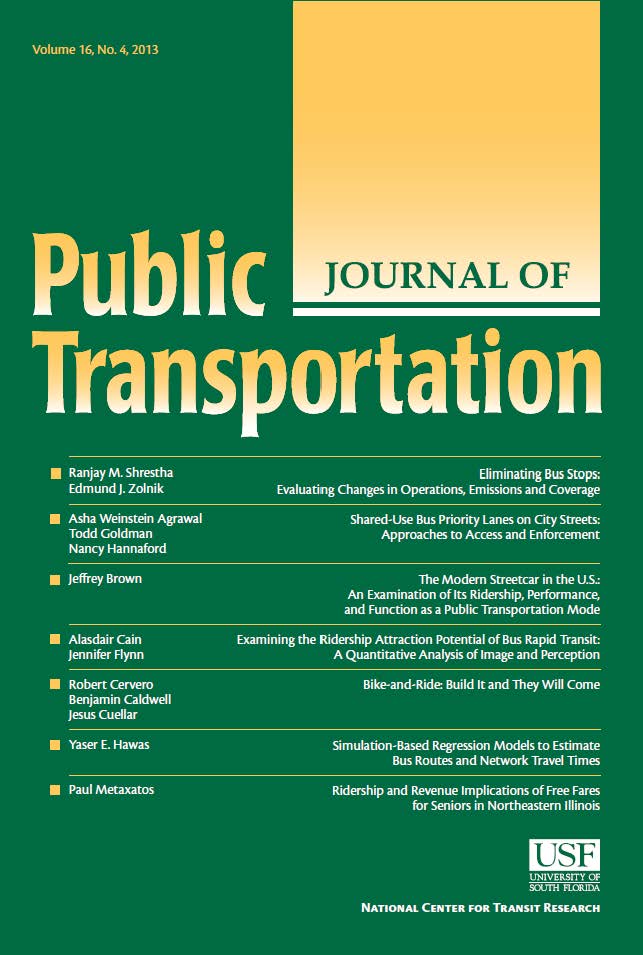How flexible transportation services work in reality?- some insights from real-world observations
IF 2
4区 工程技术
Q3 TRANSPORTATION
引用次数: 0
Abstract
Public transportation in Japan currently faces serious challenges, including depopulation, dispersed low demand, and a shortage of drivers. To address these issues and cover wider areas with fewer drivers, flexible transport systems like demand-responsive transport (DRT) services are becoming increasingly popular, particularly in rural areas, thanks to recent advancements in Information and Communication Technologies (ICT). Despite the potential for reduced operational costs through more efficient service provision, overall costs often remain high due to increased operator and system costs. Improving the efficiency of services is crucial even for flexible transport systems. Understanding detailed traveler behaviors within these systems is essential for this purpose.
Flexible transport systems often incorporate online booking and vehicle assignment systems, allowing for the automatic collection of booking data. By analyzing this data, we can gain insights into the behaviors of travelers and the patterns of bus stop utilization. This study utilizes booking data to examine the interactions between passengers and bus stops in flexible transport systems, with a particular focus on understanding and discussing patterns of regularity and variability in both traveler behavior and bus stop usage.
The study uses nine years of booking data (2015–2023) from a mid-sized city in Gifu Prefecture, encompassing 845 passengers and 142,638 records. The analysis first explores the regularity of traveler behaviors and bus stop usage patterns, followed by a discussion on the flexibility or variability of vehicle movements.
The results show that vehicle movements are primarily driven by regular high-frequency travelers, who use the service for commuting and returning home. This dominance often excludes low-frequency random travelers from accessing the service. Additionally, it is suggested that minimizing total operational costs may not adequately assign travelers onto vehicles, and the implementation of monthly passes may further reinforce the dominance of high-frequency travelers.
These insights underscore the importance of considering service designs from various dimensions, including user behavior, spatial factors, and temporal patterns, for the effective optimization of flexible transport systems.
灵活的运输服务在现实中是如何运作的?-一些来自现实世界观察的见解
日本的公共交通目前面临着严重的挑战,包括人口减少、分散的低需求和司机短缺。为了解决这些问题并以更少的司机覆盖更广泛的地区,由于信息和通信技术(ICT)的最新进步,需求响应交通(DRT)服务等灵活的运输系统正变得越来越受欢迎,特别是在农村地区。尽管通过更有效的服务提供可以降低运营成本,但由于操作人员和系统成本的增加,总体成本通常仍然很高。即使对于灵活的运输系统,提高服务效率也是至关重要的。了解这些系统中详细的旅行者行为对于实现这一目的至关重要。灵活的运输系统通常包括在线预订和车辆分配系统,允许自动收集预订数据。通过分析这些数据,我们可以了解乘客的行为和公交车站的使用模式。本研究利用订票数据来考察灵活交通系统中乘客与公交站点之间的相互作用,特别侧重于理解和讨论乘客行为和公交站点使用的规律性和可变性模式。这项研究使用了岐阜县一个中等城市9年(2015-2023年)的订票数据,包括845名乘客和142638条记录。分析首先探讨了旅客行为和公交车站使用模式的规律性,然后讨论了车辆运动的灵活性或可变性。结果显示,车辆的移动主要是由频繁出行的人驱动的,他们使用这项服务上下班和回家。这种优势往往排除了低频率随机旅行者访问服务。此外,建议最小化总运营成本可能无法充分分配旅客到车辆上,而月票的实施可能进一步加强高频旅客的主导地位。这些见解强调了从不同维度考虑服务设计的重要性,包括用户行为、空间因素和时间模式,以有效优化灵活的运输系统。
本文章由计算机程序翻译,如有差异,请以英文原文为准。
求助全文
约1分钟内获得全文
求助全文
来源期刊

Journal of Public Transportation
TRANSPORTATION-
CiteScore
6.40
自引率
0.00%
发文量
29
审稿时长
26 days
期刊介绍:
The Journal of Public Transportation, affiliated with the Center for Urban Transportation Research, is an international peer-reviewed open access journal focused on various forms of public transportation. It publishes original research from diverse academic disciplines, including engineering, economics, planning, and policy, emphasizing innovative solutions to transportation challenges. Content covers mobility services available to the general public, such as line-based services and shared fleets, offering insights beneficial to passengers, agencies, service providers, and communities.
 求助内容:
求助内容: 应助结果提醒方式:
应助结果提醒方式:


